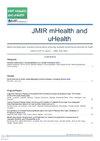Efficacy of a Web-Based Home Blood Pressure Monitoring Program in Improving Predialysis Blood Pressure Control Among Patients Undergoing Hemodialysis: Randomized Controlled Trial
IF 5.4
2区 医学
Q1 HEALTH CARE SCIENCES & SERVICES
引用次数: 0
Abstract
Background: Hypertension is highly prevalent among patients undergoing hemodialysis, with a significant proportion experiencing poorly controlled blood pressure (BP). Digital BP management in this population has been underutilized. Objective: This study aimed to explore the efficacy of a Web-based home blood pressure monitoring (HBPM) program in improving pre-dialysis BP control and enhancing knowledge, perception and adherence to HBPM among hypertensive patients undergoing hemodialysis. Methods: A multicenter, open-label, randomized controlled trial was conducted at two hemodialysis units. Patients were randomly allocated in a 1:1 ratio to either the Web-based HBPM program as the intervention group or to usual care as the control group over a 6-month period. The primary outcomes were the pre-dialysis BP control rate, defined as less than 140/90 mmHg, and the pre-dialysis systolic blood pressure (SBP), diastolic blood pressure (DBP), assessed from baseline to the 6-month follow-up. Secondary outcomes included patient knowledge, perception, and adherence to HBPM, evaluated using the home blood pressure monitoring knowledge questionnaire (HBPMKQ), home blood pressure monitoring perception scale (HBPMPS), and home blood pressure monitoring adherence scale (HBPMAS), respectively. The generalized estimating equations analysis was utilized to analyze the primary outcomes in the intention-to-treat analysis. Results: Of the 165 patients enrolled in the program (n=84, Web-based HBPM group; n=81, control group), 145 completed the follow-up assessment. During follow-up period, 11 instances of hypotension occurred in 9 patients in the Web-based HBPM group, compared to 15 events in 14 patients in the control group. The pre-dialysis BP control rate increased from 29.8% to 47.6% in the Web-based HBPM group after the 6-month intervention, while in the control group, it decreased from 37% to 24.7% (x2 =16.82, P <.001; OR = 5.11, 95%CI 2.14–12.23, P <.001). The Web-based HBPM group demonstrated a significant reduction after the 6-month intervention in the pre-dialysis SBP (t =2.46, P =.02; β = −6.09, 95%CI −10.94 – −1.24, P =.01), and the pre-dialysis DBP (t =3.20, P =.002; β = −4.93, 95%CI −7.93 – −1.93, P =.001). Scores on HBPMKQ (t = -9.18, P <.001), HBPMPS (t = −10.65, P <.001), and HBPMAS (t =−8.04, P <.001) were significantly higher after 6-months of intervention. Conclusions: Implementation of a Web-based HBPM program can enhance pre-dialysis BP control, and the knowledge, perception, and adherence to HBPM among patients undergoing hemodialysis. This Web-based HBPM program should be promoted in appropriate clinical settings. Clinical Trial: China Clinical Trial Registration Center ChiCTR2100051535; https://www.chictr.org.cn/showproj.html?proj=133286基于网络的家庭血压监测计划对改善血液透析患者透析前血压控制的效果:随机对照试验
背景:高血压在接受血液透析的患者中发病率很高,其中很大一部分患者血压(BP)控制不佳。在这一人群中,数字化血压管理一直未得到充分利用。研究目的本研究旨在探讨基于网络的家庭血压监测(HBPM)项目在改善血液透析患者透析前血压控制以及增强其对 HBPM 的了解、认知和依从性方面的效果。方法:在两家血液透析单位开展了一项多中心、开放标签、随机对照试验。患者按 1:1 的比例随机分配到基于网络的 HBPM 计划作为干预组或常规护理作为对照组,为期 6 个月。主要结果是透析前血压控制率(定义为低于 140/90 mmHg)、透析前收缩压 (SBP) 和舒张压 (DBP),从基线到 6 个月随访期间进行评估。次要结果包括患者对家庭血压监测的知识、感知和依从性,分别使用家庭血压监测知识问卷(HBPMKQ)、家庭血压监测感知量表(HBPMPS)和家庭血压监测依从性量表(HBPMAS)进行评估。采用广义估计方程分析法对意向治疗分析中的主要结果进行分析。结果:165 名患者参加了该项目(网络 HBPM 组 84 人;对照组 81 人),其中 145 人完成了随访评估。在随访期间,网络 HBPM 组有 9 名患者发生了 11 次低血压,而对照组有 14 名患者发生了 15 次低血压。经过 6 个月的干预后,网络 HBPM 组透析前血压控制率从 29.8% 上升到 47.6%,而对照组则从 37% 下降到 24.7%(x2 =16.82,P <.001;OR = 5.11,95%CI 2.14-12.23,P <.001)。基于网络的 HBPM 组在 6 个月的干预后,透析前 SBP(t =2.46,P =.02;β = -6.09,95%CI -10.94--1.24,P =.01)和透析前 DBP(t =3.20,P =.002;β = -4.93,95%CI -7.93--1.93,P =.001)显著下降。干预 6 个月后,HBPMKQ(t = -9.18,P <.001)、HBPMPS(t = -10.65,P <.001)和 HBPMAS(t =-8.04,P <.001)的得分显著提高。结论实施基于网络的 HBPM 计划可以提高血液透析患者透析前的血压控制、对 HBPM 的认识、感知和依从性。这种基于网络的 HBPM 计划应在适当的临床环境中推广。临床试验:中国临床试验注册中心 ChiCTR2100051535; https://www.chictr.org.cn/showproj.html?proj=133286
本文章由计算机程序翻译,如有差异,请以英文原文为准。
求助全文
约1分钟内获得全文
求助全文
来源期刊

JMIR mHealth and uHealth
Medicine-Health Informatics
CiteScore
12.60
自引率
4.00%
发文量
159
审稿时长
10 weeks
期刊介绍:
JMIR mHealth and uHealth (JMU, ISSN 2291-5222) is a spin-off journal of JMIR, the leading eHealth journal (Impact Factor 2016: 5.175). JMIR mHealth and uHealth is indexed in PubMed, PubMed Central, and Science Citation Index Expanded (SCIE), and in June 2017 received a stunning inaugural Impact Factor of 4.636.
The journal focusses on health and biomedical applications in mobile and tablet computing, pervasive and ubiquitous computing, wearable computing and domotics.
JMIR mHealth and uHealth publishes since 2013 and was the first mhealth journal in Pubmed. It publishes even faster and has a broader scope with including papers which are more technical or more formative/developmental than what would be published in the Journal of Medical Internet Research.
 求助内容:
求助内容: 应助结果提醒方式:
应助结果提醒方式:


